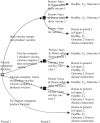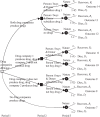A Game Theoretic Analysis of Competition Between Vaccine and Drug Companies during Disease Contraction and Recovery
- PMID: 34738510
- PMCID: PMC9189729
- DOI: 10.1177/0272989X211053563
A Game Theoretic Analysis of Competition Between Vaccine and Drug Companies during Disease Contraction and Recovery
Abstract
Background: Infectious diseases such as COVID-19 and HIV/AIDS are behaviorally challenging for persons, vaccine and drug companies, and donors.
Methods: In 3 linked games in which a disease may or may not be contracted, persons choose risky or safe behavior (game 1). Two vaccine companies (game 2) and 2 drug companies (game 3) choose whether to develop vaccines and drugs. Each person chooses whether to buy 1 vaccine (if no disease contraction) or 1 drug (if disease contraction). A donor subsidizes vaccine and drug developments and purchases. Nature probabilistically chooses disease contraction, recovery versus death with and without each drug, and whether vaccines and drugs are developed successfully. COVID-19 data are used for parameter estimation.
Results: Each person chooses risky behavior if its utility outweighs safe behavior, accounting for nature's probability of disease contraction which depends on how many are vaccinated. Each person buys a vaccine or drug if the companies produce them and if their utilities (accounting for side effects and virus mutation) outweigh the costs, which may be subsidized by a sponsor.
Discussion: Drug purchases depend on nature's recovery probability exceeding the probability in the absence of a drug. Each company develops and produces a vaccine or drug if nature's probability of successful development is high, if sufficiently many persons buy the vaccine or drug at a sales price that sufficiently exceeds the production price, and if the donor sponsors.
Conclusion: Accounting for all players' interlinked decisions allowing 14 outcomes, which is challenging without a game theoretic analysis, the donor maximizes all persons' expected utilities at the societal level to adjust how persons' purchases and the companies' development and production are subsidized.
Highlights: A game theoretic approach can help explain the production decisions of vaccine and drug companies, and the decisions of persons and a donor, impacted by Nature.In 3 linked games, N persons choose risky behavior if its utility outweighs safe behavior.Vaccine and drug companies develop vaccines and drugs sponsored by a donor if profitable, allowing 14 outcomes.
Keywords: COVID-19; death; disease contraction; donors; drug companies; drug development; game theory; patients; recovery; safe versus risky behavior; subsidies; vaccine companies; vaccine development.
Conflict of interest statement
The authors declared no potential conflicts of interest with respect to the research, authorship, and/or publication of this article.
Figures





Similar articles
-
Decisions of persons, the pharmaceutical industry, and donors in disease contraction and recovery assuming virus mutation.Health Econ Rev. 2021 Jul 23;11(1):26. doi: 10.1186/s13561-021-00320-4. Health Econ Rev. 2021. PMID: 34297215 Free PMC article.
-
The effect of framing and communicating COVID-19 vaccine side-effect risks on vaccine intentions for adults in the UK and the USA: A structured summary of a study protocol for a randomized controlled trial.Trials. 2021 Sep 6;22(1):592. doi: 10.1186/s13063-021-05484-2. Trials. 2021. PMID: 34488843 Free PMC article.
-
The Rapid Development and Early Success of Covid 19 Vaccines Have Raised Hopes for Accelerating the Cancer Treatment Mechanism.Arch Razi Inst. 2021 Mar;76(1):1-6. doi: 10.22092/ari.2021.353761.1612. Epub 2021 Mar 1. Arch Razi Inst. 2021. PMID: 33818952 Free PMC article.
-
Option-based guarantees to accelerate urgent, high-risk vaccines: a new market-shaping approach.F1000Res. 2020 Sep 18;9:1154. doi: 10.12688/f1000research.26482.2. eCollection 2020. F1000Res. 2020. PMID: 33500777 Free PMC article. Review.
-
Super-rapid race for saving lives by developing COVID-19 vaccines.J Integr Bioinform. 2021 Mar 25;18(1):27-43. doi: 10.1515/jib-2021-0002. J Integr Bioinform. 2021. PMID: 33761582 Free PMC article. Review.
Cited by
-
Game-theoretic analysis of governance and corruption in China's pharmaceutical industry.Front Med (Lausanne). 2024 Aug 14;11:1439864. doi: 10.3389/fmed.2024.1439864. eCollection 2024. Front Med (Lausanne). 2024. PMID: 39206179 Free PMC article.
References
-
- KCBD11. Live coronavirus COVID-19 global cases map. Available from: https://www.kcbd.com/2020/03/16/live-coronavirus-covid-global-cases-map/. Accessed March 5, 2021.
-
- amfAR. Available from: https://www.amfar.org/about-hiv-and-aids/facts-and-stats/statistics--wor.... Accessed March 5, 2021.
MeSH terms
Substances
LinkOut - more resources
Full Text Sources
Medical

